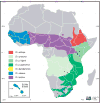Morphological variation in the genus Chlorocebus: Ecogeographic and anthropogenically mediated variation in body mass, postcranial morphology, and growth
- PMID: 29577231
- PMCID: PMC6039265
- DOI: 10.1002/ajpa.23459
Morphological variation in the genus Chlorocebus: Ecogeographic and anthropogenically mediated variation in body mass, postcranial morphology, and growth
Abstract
Objectives: Direct comparative work in morphology and growth on widely dispersed wild primate taxa is rarely accomplished, yet critical to understanding ecogeographic variation, plastic local variation in response to human impacts, and variation in patterns of growth and sexual dimorphism. We investigated population variation in morphology and growth in response to geographic variables (i.e., latitude, altitude), climatic variables (i.e., temperature and rainfall), and human impacts in the vervet monkey (Chlorocebus spp.).
Methods: We trapped over 1,600 wild vervets from across Sub-Saharan Africa and the Caribbean, and compared measurements of body mass, body length, and relative thigh, leg, and foot length in four well-represented geographic samples: Ethiopia, Kenya, South Africa, and St. Kitts & Nevis.
Results: We found significant variation in body mass and length consistent with Bergmann's Rule in adult females, and in adult males when excluding the St. Kitts & Nevis population, which was more sexually dimorphic. Contrary to Rensch's Rule, although the South African population had the largest average body size, it was the least dimorphic. There was significant, although very small, variation in all limb segments in support for Allen's Rule. Females in high human impact areas were heavier than those with moderate exposures, while those in low human impact areas were lighter; human impacts had no effect on males.
Conclusions: Vervet monkeys appear to have adapted to local climate as predicted by Bergmann's and, less consistently, Allen's Rule, while also responding in predicted ways to human impacts. To better understand deviations from predicted patterns will require further comparative work in vervets.
Keywords: Chlorocebus; growth; life history; sexual dimorphism; vervet.
© 2018 Wiley Periodicals, Inc.
Figures






Similar articles
-
A comparison of adult body size between captive and wild vervet monkeys (Chlorocebus aethiops sabaeus) on the island of St. Kitts.Primates. 2016 Apr;57(2):211-20. doi: 10.1007/s10329-015-0509-8. Epub 2016 Jan 22. Primates. 2016. PMID: 26801341 Free PMC article.
-
Morphological variability or inter-observer bias? A methodological toolkit to improve data quality of multi-researcher datasets for the analysis of morphological variation.Am J Biol Anthropol. 2024 Jan;183(1):60-78. doi: 10.1002/ajpa.24836. Epub 2023 Aug 21. Am J Biol Anthropol. 2024. PMID: 37607125
-
Geographic variation in body form of prehistoric Jomon males in the Japanese archipelago: its ecogeographic implications.Am J Phys Anthropol. 2012 Sep;149(1):125-35. doi: 10.1002/ajpa.22112. Epub 2012 Jul 13. Am J Phys Anthropol. 2012. PMID: 22791466
-
Rensch's rule, Bergmann's effect and adult sexual dimorphism in wild monogamous owl monkeys (Aotus azarai) of Argentina.Am J Phys Anthropol. 2011 Sep;146(1):38-48. doi: 10.1002/ajpa.21541. Am J Phys Anthropol. 2011. PMID: 21710658
-
Growth, development, and sexual dimorphism in vervet monkeys (Cercopithecus aethiops) at four sites in Kenya.Am J Phys Anthropol. 1997 May;103(1):19-35. doi: 10.1002/(SICI)1096-8644(199705)103:1<19::AID-AJPA3>3.0.CO;2-8. Am J Phys Anthropol. 1997. PMID: 9185950 Review.
Cited by
-
Epigenetic clock and methylation studies in vervet monkeys.Geroscience. 2022 Apr;44(2):699-717. doi: 10.1007/s11357-021-00466-3. Epub 2021 Sep 30. Geroscience. 2022. PMID: 34591235 Free PMC article.
-
ACE2 and TMPRSS2 variation in savanna monkeys (Chlorocebus spp.): Potential risk for zoonotic/anthroponotic transmission of SARS-CoV-2 and a potential model for functional studies.PLoS One. 2020 Jun 23;15(6):e0235106. doi: 10.1371/journal.pone.0235106. eCollection 2020. PLoS One. 2020. PMID: 32574196 Free PMC article.
-
The ontogeny of sexual dimorphism in free-ranging rhesus macaques.Am J Biol Anthropol. 2022 Feb;177(2):314-327. doi: 10.1002/ajpa.24442. Epub 2022 Jan 21. Am J Biol Anthropol. 2022. PMID: 35571460 Free PMC article.
-
Coming to the Caribbean-acclimation of Rhesus macaques (Macaca mulatta) at Cayo Santiago.Am J Biol Anthropol. 2023 Jun;181(2):271-295. doi: 10.1002/ajpa.24748. Epub 2023 Apr 21. Am J Biol Anthropol. 2023. PMID: 37083128 Free PMC article.
-
Dynamics of Intersexual Dominance and Adult Sex- Ratio in Wild Vervet Monkeys.Front Psychol. 2020 May 14;11:839. doi: 10.3389/fpsyg.2020.00839. eCollection 2020. Front Psychol. 2020. PMID: 32477214 Free PMC article.
References
-
- Albrecht GH. Latitudinal, taxonomic, sexual, and insular determinants of size variation in pigtail macaques, Macaca nemestrina. Am J Primatol. 1980;1:141–152.
-
- Albrecht GH, Jenkins PD, Godfrey LR. Ecogeographic size variation among the living and subfossil prosimians of Madagascar. Am J Primatol. 1990;22:1–50. - PubMed
-
- Allen JA. The influence of physical conditions in the genesis of species. Radic Rev. 1877;1:108–140.
-
- Altmann J, Alberts SC. Growth rates in a wild primate population: ecological influences and maternal effects. Behav Ecol Sociobiol. 2005;57:490–501.
-
- Altmann J, Altmann S, Hausfater G. Physical maturation and age estimates of yellow baboons, Papio cynocephalus, in Amboseli National Park, Kenya. Am J Primatol. 1981;1:389–399. - PubMed
Publication types
MeSH terms
Grants and funding
LinkOut - more resources
Full Text Sources
Other Literature Sources
Miscellaneous

